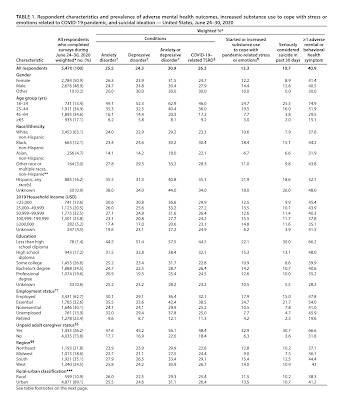
With the COVID-19 pandemic grinding onwards as the mainstream media now reports cases rather than deaths to keep the public panicking, recent research from the Centers for Disease Control and Prevention provides us with key insight into the real and very disturbing human cost of the pandemic/casedemic.
In a recent Morbidity and Mortality Weekly Report (MMWR), the CDC looks at the impact of the coronavirus disease 2019 pandemic and the impact of measures including physical distancing and stay-at-home orders on the mental health of Americans and the resulting morbidity and mortality. To assess mental health, substance abuse and suicidal ideation during the pandemic, the authors of the study used adults (minimum age of 18 years) that were resident in the United States as of April 2 to 8, 2020. During the week of June 24 to 30, 2020, a total of 5,412 out of a total of 9,896 eligible invited adults who met these requirements completed web-based surveys after being informed of the purposes of the study. Symptoms of anxiety disorder and depressive disorder were assess using the four-time Patient Health Questionnaire; those who scored three or more out of six on the Generalized Anxiety Disorder and Patient Health Questionnaire subscales were considered symptomatic for these disorders. Symptoms of a COVID-19-related Trauma- and Stressor-Related Disorders (TSRD) were assessed using the six item Impact of Event Scale which screens for overlapping symptoms of Post-Traumatic Stress Disorder (PTSD), Acute Stress Disorder (ASD) and Adjustment Disorder (AD). For this survey, the COVID-19 pandemic was specified as the traumatic exposure to record peri- (around or about) and post-traumatic symptoms associated with the wide range of stressors that were created by the COVID-19 pandemic.
Here are the results:
1.) 40.9 percent of the respondents reported an adverse mental or behavioural health condition related to COVID-19.
2.) 30.9 percent of the respondents reported symptoms of anxiety disorder or depressive disorder.
3.) 26.3 percent of the respondents reported symptoms of Trauma- and Stressor-Related Disorder.
4.) 13.3 percent of the respondents reported either starting or increasing the use of substances (alcohol, legal or illegal drugs or prescription drugs).
5.) 10.7 percent of the respondents reported having seriously considered suicide in the preceding 30 days.
Mental health issues related to COVID-19 varied with age as with at least one adverse mental or behavioural health symptom being reported by 74.9 percent of respondents aged 18 to 24 years of age and 51.9 percent of respondents aged 25 to 44 years of age. Mental health issues related to COVID-19 also varied with gender, race, household income level and education.
Let's focus on the issue of suicidal ideation:
1.) Gender – 21.6 percent of males compared to 8.9 percent of females.
2.) Age – 25.5 percent of 18 to 24 year olds compared to 16 percent of 25 to 44 year olds, 3.8 percent of 45 to 64 year olds and 2.0 percent of those 65 years of age and older.
3.) Race – 7.9 percent of non-Hispanic whites compared to 15.1 percent of non-Hispanic blacks, 6.6 percent of Asians and 18.6 percent of Hispanics.
4.) Household Income – rates of suicidal ideation varied relatively little when measured using household income, ranging from 9.9 percent for households with incomes of less than $25,000 to 11.7 percent for households with incomes between $100,999 and $199,999.
5.) Education – 30 percent of those with less than a high school diploma compared to 13.1 percent for those with a high school diploma, 8.6 percent for those with some college, 10.7 percent for those with a Bachelor's Degree and 12.6 percent for those with a professional degree.
When measured using employment status, suicidal ideation was highest among essential workers at 21.7 percent followed by 15.0 percent of employed respondents, 7.8 percent of non-essential workers and 4.7 percent of unemployed respondents.
In case you are interested, here is a table which summarizes all of the results of the survey:
Let's close with a quote from the study:
"Elevated levels of adverse mental health conditions, substance use, and suicidal ideation were reported by adults in the United States in June 2020. The prevalence of symptoms of anxiety disorder was approximately three times those reported in the second quarter of 2019 (25.5% versus 8.1%), and prevalence of depressive disorder was approximately four times that reported in the second quarter of 2019 (24.3% versus 6.5%). However, given the methodological differences and potential unknown biases in survey designs, this analysis might not be directly comparable with data reported on anxiety and depression disorders in 2019
Approximately one quarter of respondents reported symptoms of a TSRD related to the pandemic, and approximately one in 10 reported that they started or increased substance use because of COVID-19. Suicidal ideation was also elevated; approximately twice as many respondents reported serious consideration of suicide in the previous 30 days than did adults in the United States in 2018, referring to the previous 12 months (10.7% versus 4.3%).
Mental health conditions are disproportionately affecting specific populations, especially young adults, Hispanic persons, black persons, essential workers, unpaid caregivers for adults, and those receiving treatment for pre-existing psychiatric conditions. Unpaid caregivers for adults, many of whom are currently providing critical aid to persons at increased risk for severe illness from COVID-19, had a higher incidence of adverse mental and behavioral health conditions compared with others. Although unpaid caregivers of children were not evaluated in this study, approximately 39% of unpaid caregivers for adults shared a household with children (compared with 27% of other respondents). Caregiver workload, especially in multigenerational caregivers, should be considered for future assessment of mental health, given the findings of this report and hardships potentially faced by caregivers."
The full impact of the COVID-19 pandemic and the resulting actions taken by all levels of government have, without a doubt, had a significant negative impact on the mental health of Americans. What should be of extreme concern is the high levels of both suicidal ideation and increased use of substances, issues that could continue to haunt the United States for months and years to come.
Click HERE to read more from this author.
You can publish this article on your website as long as you provide a link back to this page.


Be the first to comment